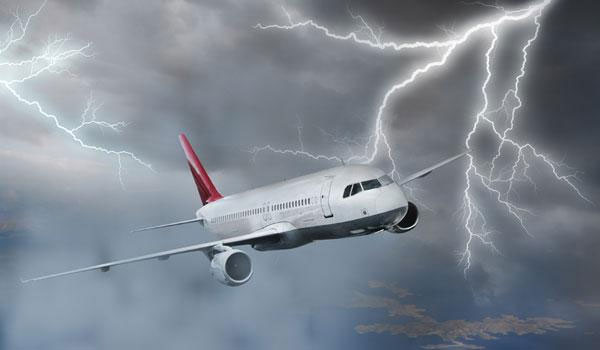How is the aircraft protected against lightning?
When an aircraft is struck by lightning, the most affected part is the tip of the wing or tail, but nothing serious will happen if the aircraft is designed to protect against the effects of lightning.
>>>Laser blocking missiles - Aerial protection solution
When struck by lightning, the aircraft may have to lower altitude, make an emergency landing or redirect it to ensure safety . This is the case with the flight bearing the EZY6025 number of easyJet. When struck by lightning, the plane carrying 154 passengers aboard from Bristol, England, to Barcelona, Spain, had to redirect and landed at another airport.
According to an estimate of an American technology company, the average US commercial aircraft is hit by lightning more than once a year. The last time a commercial plane fell because it was directly related to lightning was in 1967, when lightning struck the fuel tank. Private aircraft are thought to be less prone to lightning strikes, as they are smaller in size and can often avoid weather conditions that are prone to lightning.Normally, aircraft will be affected in sharp parts such as tail or wing tip.
Since then, many studies have been done to understand the impact and effects of lightning on aircraft, and improved protection technologies over time. Today, aircraft are tested and tested to confirm the safety of flying in lightning weather conditions.

When struck by lightning, aircraft are often affected in the tail or wing tip.(Artwork: gizmodo.co.uk)
When lightning hits a plane, passengers and flight crews can see the light flash and hear loud noises, however, nothing serious will happen. At this point, the plane continues to move in the sky, passing through the lightning. On the fuselage, electric current flows through the outer crust or some other structure and focuses on sharp parts like the tail. Pilots can see the gleaming wax rays in a short period of time in these parts of the aircraft.
Lightning protection design of aircraft
Since the 1930s, aircraft have been designed to protect against the effects of lightning. Basically, the design of the aircraft will ensure that the lightning is scattered across the points with the same device as the antenna on the wing, causing the current to flow only around the aircraft.
The cover of the aircraft is made primarily of aluminum, a good conductive material. With a non-gap design on the electrical path, the current will only flow through the aircraft's outer shell without affecting the interior. Modern aircraft made from advanced composite materials, less conductive than aluminum, will be lined with fiber or conductive membranes. Thanks to this design, the external structure of the aircraft and the sensitive internal equipment are not affected.
For modern passenger aircraft, aircraft protection solutions also include long-distance lines, equipment, computers and other control parts. Parts of safety aircraft protection systems in flight, or landing must be certified by the manufacturer, according to the standards of the US Federal Aviation Administration (FAA) or similar agencies in each country.
An important part of aircraft is the fuel system , where only a small spark can cause disaster. To ensure safety, the outer casing of the fuel compartment must be thick enough, the components or screws must be tightly designed to help prevent electrical current from moving from one area to another. Cavity door, fuel compartment cover, vent, piping system and fuel conductor, engine should be tested for lightning resistance. Today, many airlines have used a new, less explosive fuel, to limit the risk of accidents.
The parts containing the cone-shaped radar on the plane are particularly well-guarded against the effects of lightning. The radar protective cover is not made of conductive material but instead of lightning strays outside. This structure works similar to the lightning rod of buildings.
Typically, airline airlines should avoid flying or flying near stormy areas. During the flight journey, the pilot is the one who notices the slightest changes or irregularities of weather conditions. FAA has issued its own set of rules to ensure passenger aircraft safety against the effects of lightning and unusual weather conditions.
In fact, light damage cases due to lightning related to the wings of the aircraft wings, propellers or light navigation parts have been recorded in world aviation history.
- Find solutions to help the aircraft completely immune to thunder
- Video: The shocking moment of the plane hit lightning in the sky
- Why is the plane hit by lightning?
- If lightning hits the plane ...
- Why does lightning do not affect aircraft while flying?
- Passengers rest assured: Good lightning protection aircraft!
- Evaluate the possibilities that make Flight 447 disappear
- Heart with the sight of aircraft struck by lightning under the rainbow
- Aircraft with 46 holes of lightning still flew 9 hours
- Lightning disaster
- December 15, 2006 - Lockheed Martin F-35 Lightning II fighter aircraft makes the first flight
- Interesting things about lightning
 'Fine laughs' - Scary and painful torture in ancient times
'Fine laughs' - Scary and painful torture in ancient times The sequence of numbers 142857 of the Egyptian pyramids is known as the strangest number in the world - Why?
The sequence of numbers 142857 of the Egyptian pyramids is known as the strangest number in the world - Why? History of the iron
History of the iron What is alum?
What is alum?